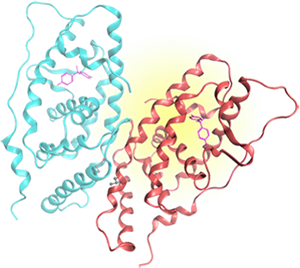
HOME / Departments / Chemistry / Structure-Function Biochemistry
Structure-Function Biochemistry
-
- MATSUSHIMA Ayami, Professor
- We have a strong interest in the molecular mechanisms of ligand-receptor interaction. There are many kinds of receptors on cell membranes, in the cytoplasm, in nuclei, etc. When a ligand binds to its specific receptor, it induces a conformational change in the receptor's structure and the signal is then transmitted. Our main research targets are nuclear receptors which precisely regulate gene transcription. We focus on all nuclear receptors to elucidate their activation mechanisms comprehensively. Binding affinity is analyzed in vitro by radioligand binding assays, and transcription activity is measured by reporter gene assays using cultured cells. The other targets are pain-modulating receptors, which are G-protein couple receptors (GPCRs).
Environmental chemistry:
Structure-activity studies between nuclear receptors and environmental chemicals
We release a diverse range of chemicals into our environment, and the effects of these environmental chemicals are poorly understood. The first step in the adverse signal transduction caused by environmental chemicals is in the binding of these chemicals to specific receptors in cells. It had previously been considered that environmental chemicals bind to sex hormone receptors such as estrogen receptors, but we now recognize that they can bind to many kinds of receptors. We focus on all of the nuclear receptors as targets of environmental chemicals. There are 48 kinds of human nuclear receptors, all of which are transcription factors regulating the expression of their target genes. We found that bisphenol A strongly binds to estrogen-related receptor gamma, which has a similar amino acid sequence to estrogen receptor encoded by a different gene. We identified bisphenol AF as a relatively strong binder to estrogen receptor alpha and beta. It elicits a unique response to estrogen receptor beta, and this result drew international attention. We explored the molecular mechanisms of how nuclear receptor subtypes control the transcription of target genes cooperatively.
Receptor chemistry:
Structure-function relationships of opioid receptors and nuclear receptors
Nuclear receptors are transcription factors controlling the transcriptions of their own target genes. Estrogen receptors alpha and beta are female sex hormone receptors, of which rational and functional differences in their functions were unknown. We are pursuing the goal of why we have two estrogen receptors, and its significance.
Brain chemistry:
Animal behavior differences induced by exposure to environmental chemicals

We analyze the biological effects of bisphenols on experimental animals such as mice by measuring the total amount of activity. To clarify their molecular mechanism, we study circadian clock genes and their encoding proteins, and neuropeptides which function in signal transduction.
Our research goal is to develop innovative molecules and even techniques, especially for improving treatments related to human health and happiness.